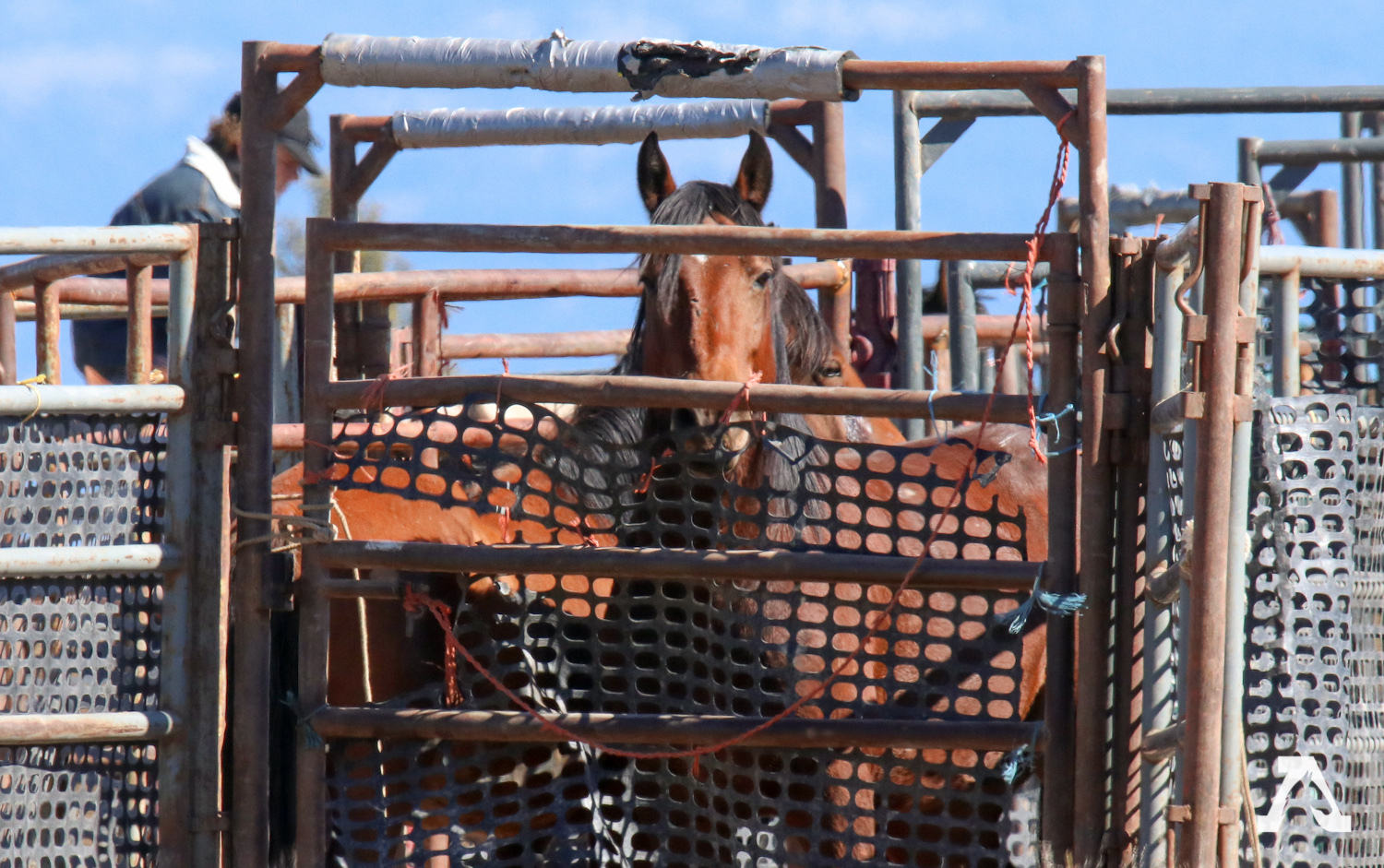While the agency has set an Appropriate Management Level of only 206-402 horses on the 258,000-acre Devil's Garden Wild Horse Territory, it authorizes as many as 3,700 cattle and 2,900 sheep to graze for six months a year. Yet, the Forest Service maintains that this roundup – the third in three years – is necessary to protect “rare and threatened native wildlife and the economy of Modoc County.”
Over the past two years, the Forest Service has rounded up and removed 1,431 Devil’s Garden horses. After this fall’s operation, that number will soar to around 2,000 horses. The cost to taxpayers for the roundups and removals alone is almost $2 million. Cattoor Livestock Roundups was awarded over $600,000 the contract for this roundup.
After processing and sorting, captured horses will be transferred to either the Forest Service’s Double Devil Wild Horse Corrals in Alturas, California or the BLM Wild Horse and Burro Corrals in Litchfield, California that is authorized to take up to 250 younger horses.
In 2019, a census by the United States Geological Survey found that there were 1,803 horses on the Territory. Although the Forest Service and local livestock operators have claimed that there are upwards of 4,000 horses, the agency’s current unscientific estimate is 1,663.
Two years ago, AWHC offered to implement and fully fund a pilot fertility control project to humanely reduce population growth rates in the herd two years ago, recommended by the National Academy of Sciences (NAS). However, the Forest Service rejected our offer, preferring instead to continue controversial, cruel, and expensive roundups and removals that are supported by its livestock allies even though the NAS found them to be unproductive and unsustainable.
In 2018, the Forest Service began selling horses – including mare/foal pairs – for $1 in an attempt to dump them and circumvent the ban on selling horses without limitations on slaughter. This year, it also offered free transportation across the country for truckloads of horses – meaning 10-35 horses – to private buyers.
The Forest Service reported that the continuation of the $1 sales fee this year will depend on the success of its three different adoption attempts. (While horses 10 and older are automatically eligible for sale, younger ones must be passed over for adoption three times.) However, given that the agency will fast track the “adoptions” and that about a dozen horses from the 2019 removal at the Double Devil corrals still haven’t been adopted or sold, expect that more horses will be available for the rock bottom price of only one dollar – less than the cost of a candy bar or can of soda!
As for another year of free shipping, the Forest Service stated it will depend on its 2021 transportation budget which it does not have at this point.
ROUNDUP REPORT
Saturday, October 3, 2020: Travesty on Devil’s Garden Wild Horse Territory Ends – 506 Horses Removed/Multiple Deaths, Injuries, and Premature Births
Less than one month after the roundup of the Devil’s Garden wild horses began, it ended with 506 horses permanently removed – 188 studs, 238 mares, and 80 weaned and unweaned foals.
Over the weekend, the final 17 horses were captured at the trap site near Telephone Flat.
According to the U.S. Forest Service, one horse died and five escaped at the trap sites during the 2020 operation. However, more horses have died while at the agency’s Double Devil Wild Horse Corrals where several other horses are being treated for injuries. Two foals were also born prematurely there; both were euthanized.
AWHC will be soon posting a blog about the 2020 Devil’s Garden roundup and removal.
October 1, 2020 – 17 More Devil’s Garden Horses Removed Using Taxpayer Money
On the third day at the trap site near Telephone Flat, the U.S. Forest Service took off another 17 horses from the Devil’s Garden Wild Horse Territory.
This week, September 25-October 1, the Forest Service reported that 157 horses were rounded and removed: 63 stallions, 75 mares, 18 weaned foals. Most of these mares are likely to be pregnant. One young mare, who appeared “ weak,” fell in the alley during sorting. However, according to the agency, after being given electrolytes, she joined the other mares in a pen. And, a young stallion is being treated for an open wound on his rump.
So far, thanks to American taxpayers, 467 horses have been removed in order to appease local ranchers who believe it is their inherent right to overgraze their private livestock on the parched, lava-strewn public lands in the Devil’s Garden Wild Horse Territory.
Although the roundup operation will continue over the weekend at the same trap site, the next update will be Monday, October 5th.
September 30, 2020: 21 More Horses Taken From Devil's Garden
The U.S. Forest Service removed 21 horses from the trap site near Telephone Flat. One lucky horse escaped, leaving behind his band. The removal will continue at the same location.
September 29 – 33 Horses Removed on Day 20 of Devil’s Garden Roundup
After moving the trap site to Telephone Flat, the U.S. Forest Service is closing in on its goal of permanently removing 500 wild horses from the Devil’s Garden Wild Horse Territory. Another 33 horses lost their freedom and families, bringing the total number to 429
September 28, 2020 - No horses were removed because the trap is being moved to a new location near Telephone Flat.
September 25, 26 and 27, 2020: 87 Additional Devil’s Garden Horses Lose Their Homes
Over the weekend, the U.S. Forest Services moved closer to its goal of removing 500 federally-protected wild horses from their federally-protected habitat on the Devil’s Garden Wild Horse Territory. So far, 396 horses have been rounded up with 27 horses being targeted on Friday, 39 on Saturday, and 21 on Sunday.
Air quality was classified as Good, and temperatures were in the 80s.
The Forest Service reported no injuries or deaths of horses during the last three days; one horse escaped the trap on Sunday.
September 24, 2020: 33 More Horses Targeted on Devil’s Garden Roundup/Removal: Death Toll and Injuries Continue to Rise
After a two-day reprieve due to helicopter maintenance, another 33 horses were removed from the trap site near Drift Fence Tank, bringing the total to 309. The goal for this 2020 roundup is 500 horses.
This week alone, 85 horses – 34 stallions and 51 mares – as well as 36 foals – 30 weaned and 6 unweaned – have been captured. Three horses escaped from the trap pen.
So far, the operation has resulted in the death of six horses. According to the Modoc National Forest (MNF), two horses were euthanized after running into corral panels and breaking their necks at the trap site and the Forest Service’s Double Devil Wild Horse Corrals. Another four stallions were euthanized as a result of complications from gelding that the contract veterinarians have attributed to “a genetic issue.”
The MNF also reported that several other horses are receiving care from pre-existing bite and kick wounds, lameness, and other injuries as well as those received during the roundup operation. Included among them are four horses under observation and pain management plans: two from bite wounds, one due to old age, and one due to a pre-existing wound.
The next update from the MNF will be Monday, Sept. 28.
September 22 and 23, 2020: No Roundup and Removal Operations Due to Scheduled Helicopter Maintenance
September 21, 2020: Forest Service Removes 25 More Devil’s Garden Wild Horses
Under a hazy blue sky, 25 horses were rounded up from the trap site near Drift Fence Tank.
The helicopter made three runs between 9:00am and 2:00pm, with each run bringing in small groups of between 7 and 10 horses. Once again, although the observation site offered a good view of the horses moving into the opening of the trap, the helicopter was working behind the tree line, so it was not possible to see how it was working the horses as it drove them to the trap.
The air quality was classified as Unhealthy.
All horses appeared in good shape with body condition scores of between four and six.
To date, 276 horses have been removed. The Forest Service’s goal for this 2020 operation is 500 horses.
There will be no round up and removal tomorrow because the helicopter will be receiving maintenance.
September 20, 2020: 21 Wild Horses Lose Their Freedom on Day 12 of the Devil’s Garden Roundup
The U.S. Forest Service removed another 21 horses – a mix of stallions, mares, and foals – from the trap site near Drift Fence Tank.
The helicopter made two runs. The first one began at around 9:00am, and by 10:00am eight horses were captured. Although 100 or more horses are reported as living near Drift Fence Tank, it appeared that the helicopter had difficulty finding more because the next group of 13 horses were not brought in until 2:30 pm. In between, the helicopter stopped once to refuel and another time to pick up an additional crew member. After that, however, it flew for between 1 and 11/2 hours before the second group was brought into the trap.
The location for public observation provided only a view of the horses moving into the funnel of the trap. Therefore, because the helicopter was working behind the treeline, we couldn’t see when it located the horses or how long or fast it drove them into the trap once it did.
To provide real time coverage that would ensure accountability during roundups, AWHC has long advocated the use of cameras in helicopters for both the Bureau of Land Management and the Forest Service. In fact, we repeatedly offered to buy them. However, both agencies have ignored our offer.
Regarding the four lame horses at the Double Devil corrals, the Forest Service classified their injuries as being “pre-existing conditions.” This is troubling, especially for stallion and mare with the foal, because it means that they were driven by the helicopter for an unknown distance and speed even though they cannot bear weight on one of their legs.
AWHC is continuing to inquire about this classification and the condition and care of these horses.
September 19, 2020: 35 Wild Horses Removed from Devil’s Garden on Day 11 of Roundup: Two Horses Escaped and Several Severely Lame Horses at the Corrals.
Today began with a tour of the Forest Service’s Double Devil Wild Horse Corrals, where almost 200 horses have been sorted into various pens by gender and location of capture.
Horses sported a spectacular range of colors, including bays, roans, sorrels, palominos, buckskins, cremellos, and greys. Most had a body condition score of 4 and 5 – meaning they were at an excellent weight. Some bordered on being obese.
We observed and photographed four horses with serious leg injuries. Of particular concern was a mare with a very young foal. Besides having a large gash on her shoulder, she was holding up her left front, unable to bear weight on it. A stallion a few pens down was also not bearing weight on his left hind.
The two other horses had significant head-bobbing limps.
AWHC observers requested a status report on these horses -- including when they were seen by a veterinarian – and the treatment plan for them.
Like yesterday, the trap was located near Drift Fence Tank in the northeast corner of the Devil’s Garden Wild Horse Territory. Temperatures were in the mid-60s, and air quality was classified as Moderate.
Starting at around 9:30 am and ending at 2:00 pm, the helicopter made four runs, bringing in small groups of between 3 and 13 or so horses per run. While visibility of the helicopter moving them into the trap was good from the observation site, because Devil’s Garden is heavily forested, we could not see how far or fast it was driving the horses. The last two runs were especially long, and the horses appeared tired when they came into sight and entered the trap and pen.
During the second run, a stallion made a desperate but unsuccessful attempt to protect his mare and foal by standing between them and the helicopter and then between them and the Judas horse, a domestic horse trained to lead wild horses into the trap.
At the end of the day, 35 were removed. However, after the roundup was called, we had a bittersweet surprise. On the way back to our vehicles, we witnessed a sorrel stallion jump over the panels of the trap pen and come galloping toward us, only to veer off to a stand of trees. At one point, he stopped, turned to face the pen and snorted several times, before leaving, never to see his family band again, who were watching him from the pen.
We did not see the other horse escape, but we wish him well.
Last week, between Friday 9/11 and Thursday 9/17, 152 horses were removed: 64 stallions, 75 mares, 12 weanlings, and 1 unweaned foal.
Fifty-seven younger horses were transported to the Bureau of Land Management Litchfield corrals.
Since the roundup started over two weeks ago, two horses have died – one at the trap site and one at the Double Devil corral and both from crashing into corral panels.
September 18, 2020: Helicopters did not fly today because of wind.
September 17th, 2020: 21 More Wild Horses Lose Their Freedom
The Forest Service removed from 21 horses from near Drift Fence Tank in the northeast corner of the Devil’s Garden Wild Horse Territory, bringing the total number of horses captured to 195.
The helicopter made four runs, starting at 9:00 am and ending at 12:45 pm after the contractor, Cattoor Livestock Roundup Company, called off the operation for the day because of increased risk of fire.
Although there was less smoke than in previous days, the air quality was classified as unhealthy. Last week, the University of California/Davis released guidelines for horses exposed to wildfire smoke that, for example, suggest limiting exercise of horses when smoke is present and giving them ample time to recover “from smoke-induced airway insult.” But apparently, given that the Forest Service is still rounding up horses during one of the worst fire seasons, those guidelines don’t apply to Devil’s Garden wild horses.
The area for public observation was about ¼ mile away from the trap site, making visibility of the horses being chased by the helicopter into the trap good; however, the view of the horses in the corral was obscured by trees.
The Forest Service still maintains that it’s finding “Happy Homes” for the Devil’s Garden horses, in spite of at least a dozen deaths of horses rounded up in 2019, either at the Forest Service’s Double Devil corrals or sold and transported to private individuals. Its reasoning: sacrificing a few wild horses benefits the majority of them.
At the end of yesterday’s operation, Troy Cattoor, owner of Cattoor Livestock Roundup Company, visited the observation site and offered his opinions on such topics as AWHC’s PZP Fertility Control Program – it’s a total failure and waste of time – and the damage that the overpopulation of wild horses are causing on public lands – refusing to entertain the notion that private cattle vastly outnumber wild horses and that, according to the National Academy of Sciences, the national Appropriate Management Level of just under 27,000 horses was not based on any legitimate science.
September 16, 2020: 6 wild horses from Devils Garden, CA were captured and removed under smokey conditions.
- Another 4 horses avoided capture by refusing to enter the trap.
- The horses are coming in with good weight and size.
- Observation offered a good view of the trap site.
- They will move the trap to another location tomorrow.
September 15, 2020: 8 wild horses from Devils Garden, CA were captured and removed under smokey conditions.
- Another 9 horse avoided capture by repeatedly refusing to go into trap.
- One red roan unsuccessfully attempted to jump trap.
- Observation offered a good view of the trap site.
- Operations appeared to run smoothly today.



Double Devil Wild Horse Corrals
- Some great looking horses with good weight and size.
- A surprising amount of color compared with previous years.
- They still have 12 bays from last years roundup.
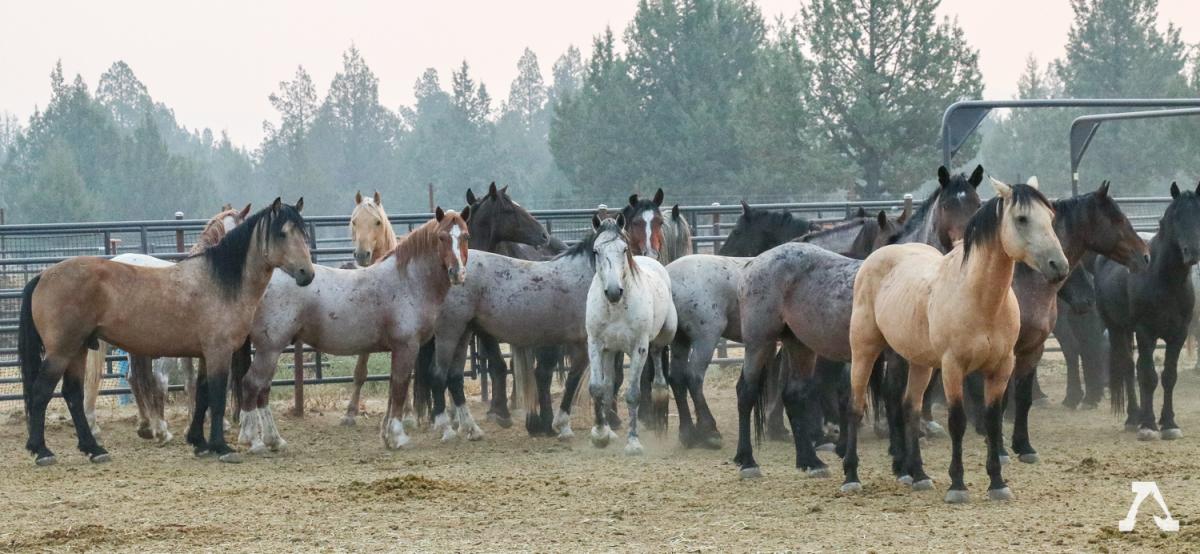

September 14, 2020: 34 wild horses from Devils Garden, CA were captured and removed under smokey conditions.
- Observation offered a good view of the trap site.
- Operations appeared to run smoothly today, without any incidents.
- Horses appeared in good weight and size, in a wide range of colors.
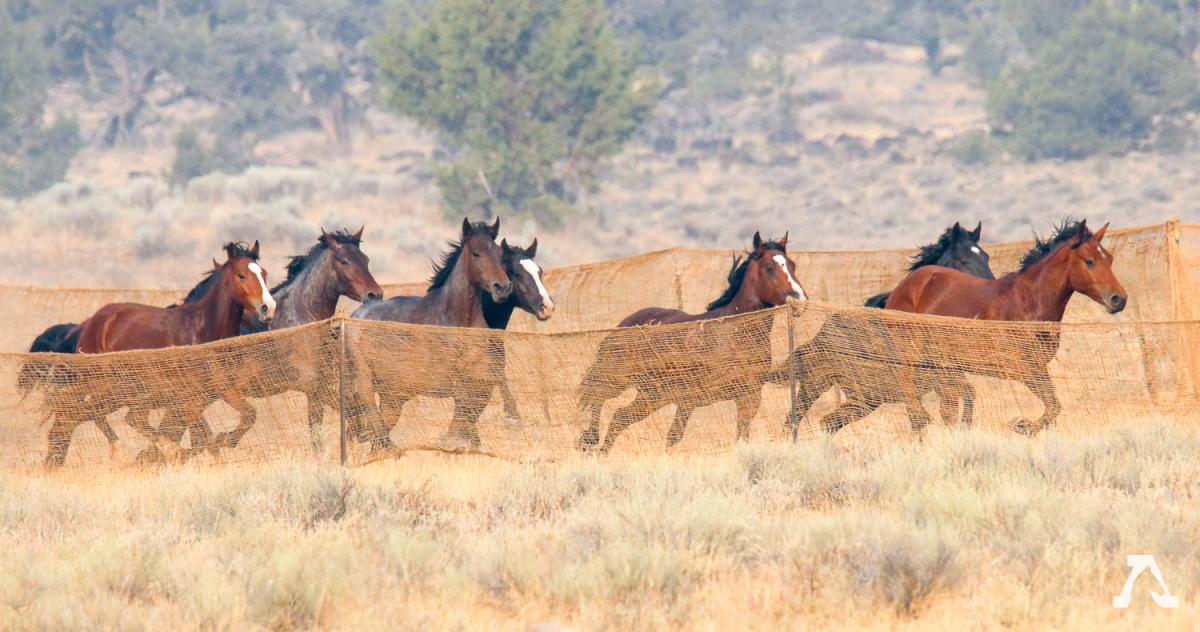
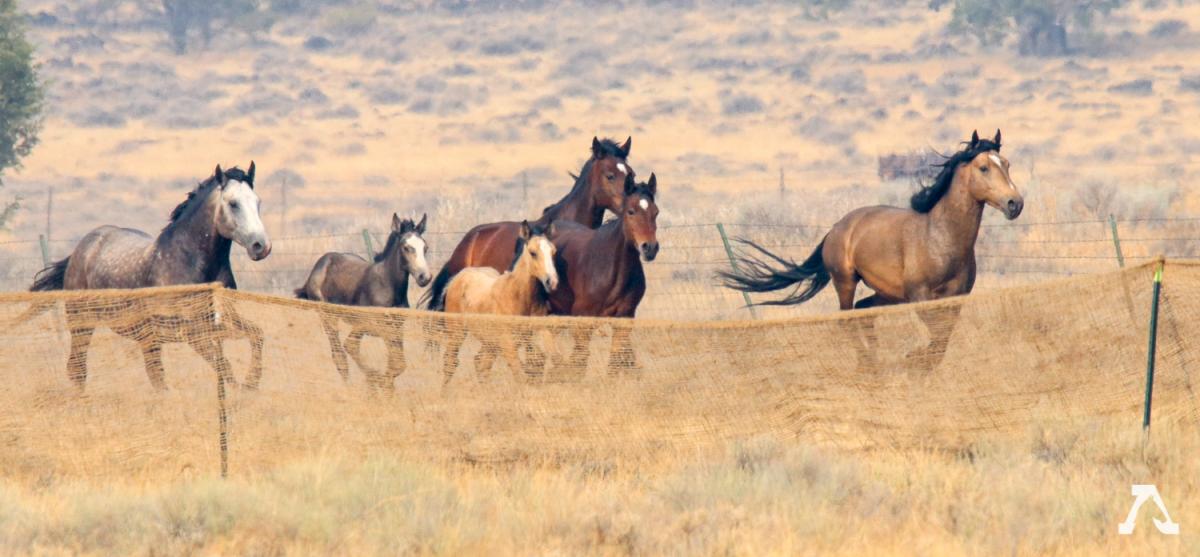

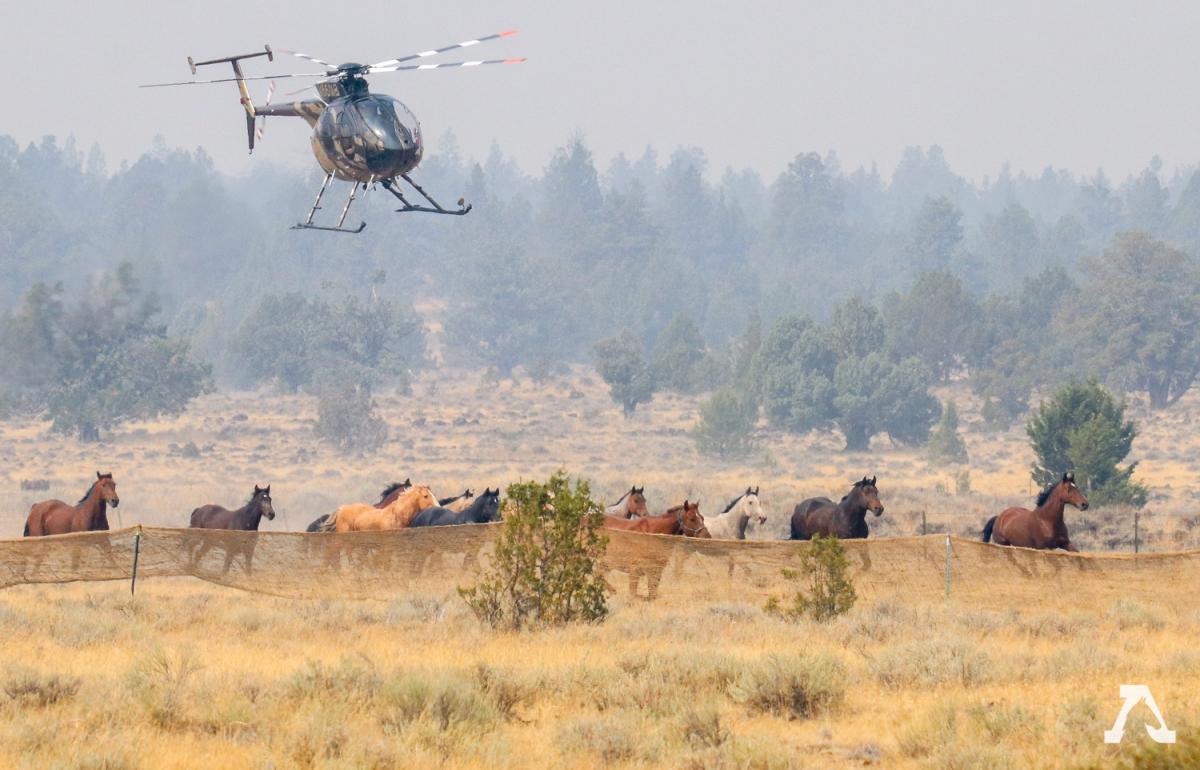


September 13, 2020: 13 wild horses were rounded up and removed under smokey conditions.
Today we had a close view of the trap wings. While there was a lot of cattle to be found in the area, the Forest Service found only a small number of horses today. The trapsite will be moved tomorrow.

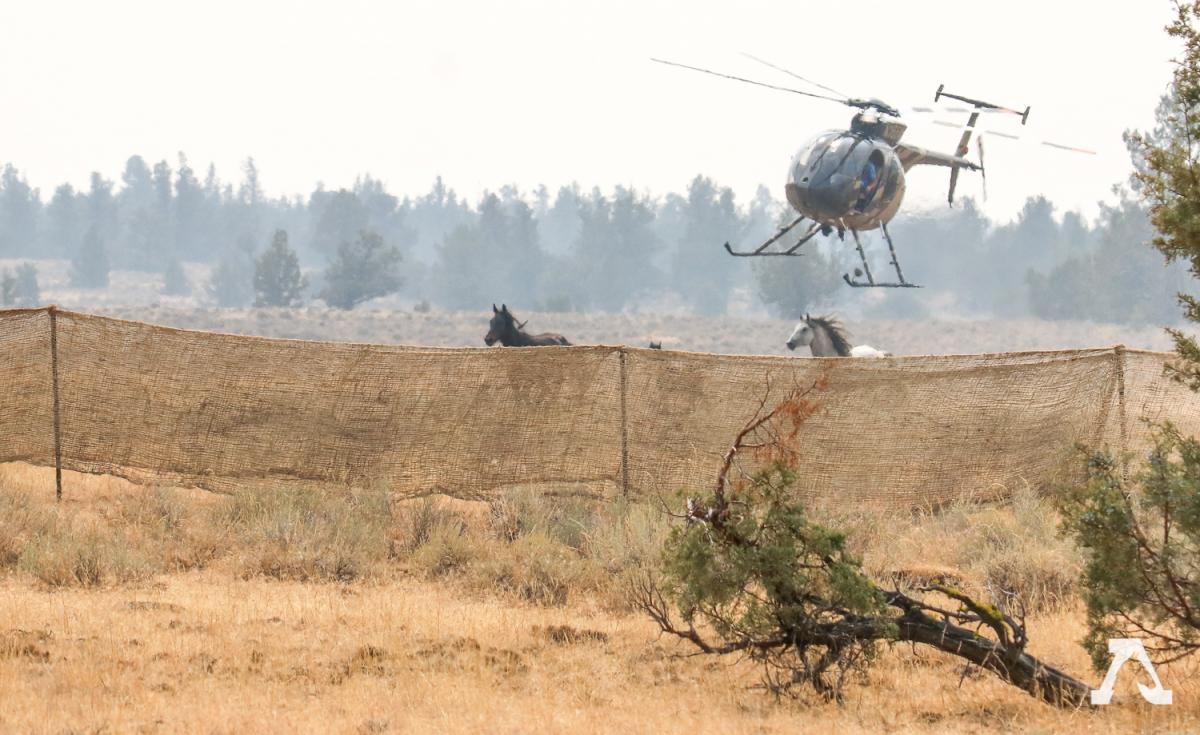
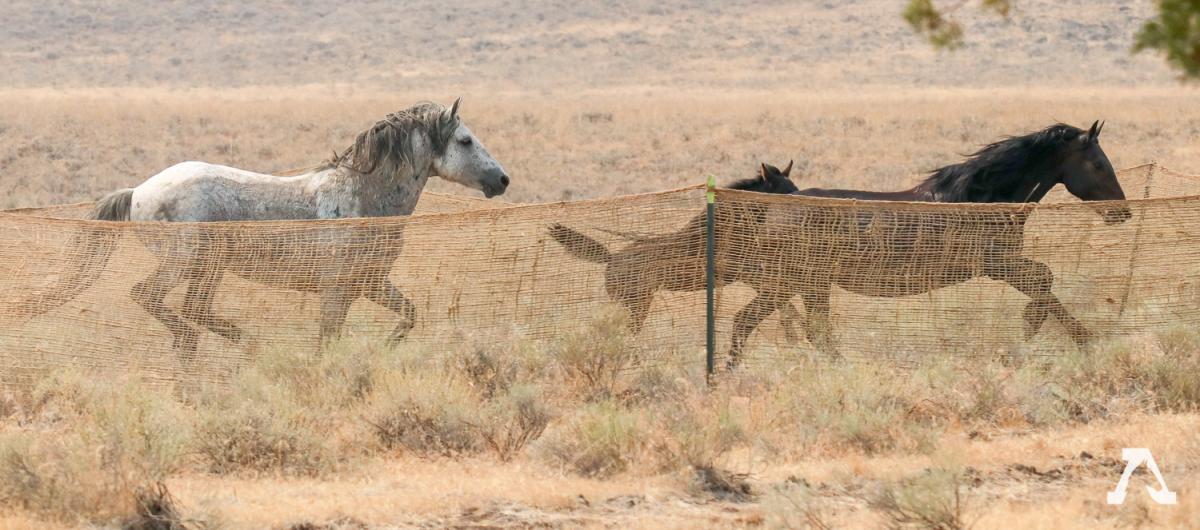

September 11 and 12, 2020: On days Three and Four of the roundup on the Devil’s Garden Wild Horse Territory, 71 horses were captured at the trap site north of Fairchild Swamp. To date, 113 horses have been removed.
According to the Forest Service, of the 42 horses removed on September 9th and 10th, 14 were studs, 19 were mares, and 9 were foals. One stallion died from an acute injury, reportedly from crashing into the corral at the trap site.
Twelve horses will be transferred to the BLM Litchfield corral, and 29 total horses have been transferred to the Double Devil Wild Horse Corrals.
September 10, 2020: On the second day of the roundup, 8 horses were captured from the trap site north of Fairchild Swamp on the Devil’s Garden Wild Horse Territory. The Modoc National Forest is promising a full update tomorrow.
September 9th, 2020: The U.S. Forest Service removed 34 horses during the first day of this fall’s helicopter roundup that is targeting 500 more California mustangs on the Devil's Garden Wild Horse Territory from within the Modoc National Forest in Alturas, California.

